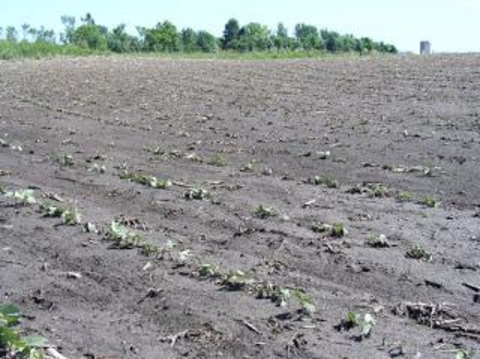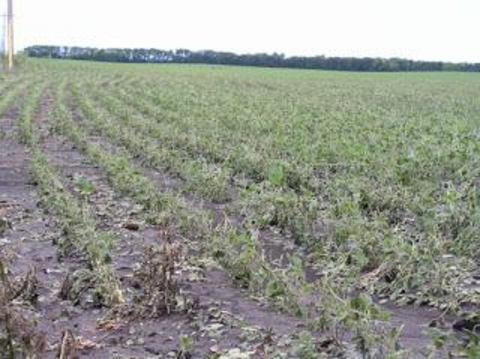What you need to know
Assessing hail damage and making replant decisions can be difficult, with many variables to consider as you decide whether to replant or maintain the existing stand.
How hail impacts yield depends when the damage occurs and its severity: May (emerging soybeans), June (seedlings) or July (mid- to late vegetative and reproductive stages).
Emerging soybean: May
While soybean is quite resistant to hail damage throughout much of its development, newly emerged soybeans are extremely sensitive to hail. This is especially true with just-emerging plants.
As soybeans begin to emerge, the hypocotyl arch is the first tissue to be exposed. This portion of the stem below the cotyledons is very susceptible to damage.
Hailstones of any size hitting this tender tissue will cut off the cotyledons. Because the growing point is at the top of the plant, any plants cut off below the cotyledon will die.
Earlier-planted soybeans may be in better shape. Soybean plants with significant amounts of remaining green tissue (more than one green cotyledon and/or remaining leaf tissue) are likely to survive early-season hail damage, as they can regrow from axillary buds located at the juncture of the stem and leaves.
Before making any replant decisions, carefully count existing live plants in a known area to determine populations on an acre basis.
One method is to count live plants in a thousandth of an acre (e.g., 17 feet, 5 inches of row in 30-inch rows or 23 feet, 9 inches of row in 22-inches rows). Then, multiply by 1,000 to estimate plants per acre.
Even soybean stands above 100,000 per acre will provide full yields at harvest, while stands of about 80,000 will produce 90 to 95 percent of the maximum yield potential.
Likewise, replanting the last week of May will likely result in yields about 90 percent of those planted during the first week of May. By knowing the break-even point for yields based on existing stands and yield penalties for late planting, producers can evaluate the other costs and benefits.
Thin soybean stands are not aesthetically pleasing and will require additional resources to manage weeds. On the other hand, replanting requires additional seed and fuel costs. Carefully weigh all additional factors including insurance, seed cost and your landlord before making the final decision to replant or not.
Seedling: June
Survivability of soybean plants
Soybean plants with significant amounts of remaining green tissue (more than one green cotyledon and/or remaining leaf tissue) are likely to survive early-season hail damage. This is because they can regrow from axillary buds located at the juncture of the stem and leaves.
Soybean plants cut below the cotyledons or entirely stripped of leaf tissue will not recover. Similarly, larger plants with a small amount of remaining green leaf material are likely to recover, but expect slow regrowth. Remaining stands will be set back.
Soybean plants with significant stem bruising may recover, but will be more susceptible to lodging late in the season.
Soybean can tolerate low plant populations well, with only small reductions in yield potential across wide ranges in stand loss.
For instance, populations near 100,000 plants per acre are likely to produce maximum yields, and those around 80,000 will yield about 90 percent of the maximum. However, expected yields to drop more rapidly in stands below 50,000, with 39,000 plants per acre likely to produce about 75 percent of the normal yield.
For soybean, leaf loss alone through the V4 stage (four fully developed trifoliolate leaves) has little effect on yield.
Only consider replanting in fields where the crop is a total loss, as the shortened season will limit yield somewhat.
Final soybean yields are penalized at a rate of about 1 percent per day. Soybeans planted on June 20 are expected to produce around 70 percent of an early-planted soybean crop. By the end of June, that number falls to around 60 percent.
How planting date affects soybean yield potential
| Planting date | Yield loss | Yield potential |
|---|---|---|
| May 1 | 0% | 100% of maximum |
| May 5 | 1% | 99% of maximum |
| May 10 | 2% | 98% of maximum |
| May 15 | 3% | 97% of maximum |
| May 20 | 6% | 94% of maximum |
| May 25 | 9% | 91% of maximum |
| May 30 | 13% | 87% of maximum |
| June 4 | 18% | 82% of maximum |
| June 9 | 24% | 76% of maximum |
| June 14 | 30% | 70% of maximum |
Maturity group
For mid-June soybean plantings, use soybean varieties that are about 0.5 maturity groups (MG) shorter than what’s considered full-season. A 1.0MG soybean would be a good fit in the Willmar/Benson/Montevideo area.
Seed availability and other factors
Replanting in mid-June is likely to produce a yield similar to that in an extremely thin soybean stand. This means you should carefully consider all tangential factors: Replanting costs, seed availability, weed control and aesthetics.
Seed availability may be the primary determinant for replanting or not. Contact your seed suppliers as soon as possible to confirm early-maturity seed is still available.
Herbicide usage and dicamba tolerance
If dicamba-tolerant soybeans were sprayed with herbicides containing dicamba, such as Xtendimax, FeXapan or Engenia, and then damaged by hail, herbicide restrictions complicate replant options.
Use caution when replanting or “spiking” in non dicamba-tolerant soybeans into these fields, because the residual soil activity of the previous application may cause crop damage.
Please refer to required rotational crop intervals on the container label, as this main label will indicate the number of days that must pass before replanting to non dicamba-tolerant soybeans.
The waiting period for Xtendimax or FeXapan can range from 14 days for applications of 11 fluid ounces or less to 28 days for applications of 22 ounces per acre. The Engenia waiting periods are 14, 21 and 28 days when the previous application was less than or equal to 6.4, 9.6 or 12.8 fluid ounces per acre, respectively.
4- to 6-leaf stage/R1: July
The yield potential of hail-damaged crops largely depends on the remaining plant population, the type and severity of damage and the growth stage when damaged.
Soybean crops have an amazing ability to respond to leaf loss from hail events. Plants with any remaining green leaf tissue will develop new leaves from existing leaf axils.
Soybeans can be nearly 100 percent defoliated at the V6 to R1 stages and still produce 80 to 90 percent of their yield potential.
Plants cut below the cotyledons or entirely stripped of leaf tissue will not recover. Plants with severe stem bruising are unlikely to produce a harvestable yield. If they can produce seed, they’re likely to fall over late in the season. Reduced stands can amplify the losses from leaf area alone.
Estimating soybean yield loss
Soybean can tolerate low plant populations well, with only small reductions in yield potential across wide ranges of stand loss.
For example, populations near 100,000 plants per acre are likely to produce maximum yields, and those around 80,000 will yield about 90 percent of the maximum.
However, expected yields to drop more rapidly in stands below 50,000. For example, populations around 39,000 plants per acre are likely to produce about 75 percent of the normal yield.
A three-year study in Lamberton. Minnesota and Ames, Iowa examined defoliation at the R1 and R3 stages at 33, 66 and 100 percent levels.
Researchers also created a second, 66 percent defoliation treatment by thinning the existing 100,000 plant stand by 50 percent and defoliating by 33 percent. This allowed for a contrast between pure leaf loss and leaf loss with reduced stands.
Effect of development stage
As expected, more severe leaf loss led to greater yield losses, and defoliation at the R3 stage produced a greater yield loss than at R1.
Leaf loss at 66 percent resulted in only a 6 percent yield loss at the R1 stage, but combining the same level of leaf loss with a reduced stand increased yield losses to 21 percent. A total loss of leaves at R1 resulted in only a 25 percent yield loss. The yield penalty from 100 percent leaf loss ballooned at the R3 stage, where we noted a 69 percent yield loss.
Late-season hail tends to reduce yields more than hail earlier in the season. Early July hail will likely lead to yield responses similar to those seen in the R1 treatments from our study. At this development stage, consider significantly thinning stands as additional yield loss.
Table 2: Soybean yield response to leaf defoliation and population thinning
| Treatment | Yield | Yield gain or loss |
|---|---|---|
| Control | 51 bushels per acre | |
| 33% defoliation at R1 | 52 bushels per acre | +1% |
| 66% defoliation at R1 | 48 bushels per acre | -6% |
| 50% thin and 33% defoliation at R1 | 41 bushels per acre | -21% |
| 100% defoliation at R1 | 38 bushels per acre | -25% |
| 33% defoliation at R3 | 48 bushels per acre | -6% |
| 66% defoliation at R3 | 39 bushels per acre | -24% |
| 50% thin and 33% defoliation at R3 | 34 bushels per acre | -34% |
| 100% defoliation at R3 | 16 bushels per acre | -69% |
Replanting considerations
You can replant soybeans, but the short remaining season will severely limit yields. Soybeans planted after July 1 routinely produce a yield less than half of normal planting dates.
Experience with soybeans after peas shows that planting a soybean variety that’s one maturity group earlier than adapted to the region before July 4 will occasionally produce reasonable yields.
Producers are rarely content with yields from crops planted a week or more after July 4. By this time, yield potentials fall to 40 percent of normal or even less. However, producers may choose to gamble on late-season replanting for weed control or other appropriate reasons.
Seed availability may be the primary factor when deciding whether to replant or not. Contact your seed suppliers as soon as possible to confirm early-maturity seed is still available.
This late date requires soybeans with maturities of more than one full maturity group shorter than adapted.
Managing damaged fields
If you choose to keep your existing crops, take care to ensure these fields produce as much as possible. Because the crop has experienced tremendous stress, it’s important to reduce the level of future stresses.
The most important and difficult challenge with hail-damaged crops often revolves around weed control. It’s challenging to maintain good weed control in an open crop canopy.
If replanting soybean, minimizing soil disturbance can reduce weed germination and maximize the effectiveness of soil-residual herbicides already applied to the field.
Planting a cover crop may be a viable option for areas where the original crop was completely lost. Additional considerations for such fields include weed control and avoiding fallow syndrome.
Reviewed in 2018



